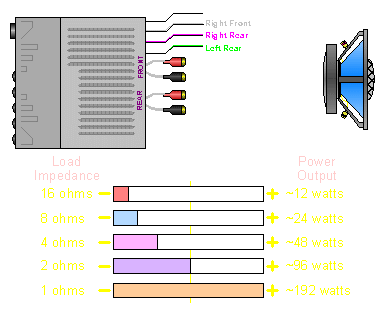|
Speaker Impedance vs Power Output
Head Unit Power:
As we said earlier, the impedance of a speaker is its opposition to the flow of A.C. current. The lower the impedance, the higher the current flow (all else being equal). Increasing the impedance will decrease the current flow (all else being equal). You probably know that car audio speakers generally have lower impedance than home or commercial speakers. As you know, there is a limited amount of voltage available in an automobile (approximately 13.8 volts). This means that head units have only 13.8 volts to apply to the speaker leads. If we have only at 13.8 volts to drive into a speaker, there may not be sufficient volume output if the speaker has high impedance. The Ohm's Law formula and diagram below show the possible power output into various speaker impedances with a 13.8 volt power supply.
P = E2/R
Power = voltage2/impedance

Notice how the power doubles each time the load impedance is reduced by ½. Now keep in mind that the output transistors/chips cannot usually deliver the entire battery voltage to the speaker leads due to inefficiencies in the semiconductors. If it could apply the FULL 13.8 volts as in the previous example, the power output shown in the diagram would be possible. Please note that those numbers would be PEAK power. The Actual RMS output would be ½ peak power.
Note:
A head unit's internal amplifier can NOT drive a 1 ohm load and survive. The impedances in the diagram are only to show how power output is related to load impedance. Check the owner's manual for your equipment's minimum load impedance.
Power Sources/Impedance:
In home/commercial amplifiers, they have a mains voltage of at least 120 volts with which to work (most actually reduce the voltage with the power transformer). This means that they can use high impedance speakers and still produce high power. Using low impedance (less than 8 ohms) speakers with home audio equipment may well cause the output transistors to fail. Home equipment is designed for high voltage, low current output. Most car audio equipment is designed to operate into lower impedance loads (4 ohms or less).
Amplifiers:
As you know, it is possible to produce more than the 45 watts peak power (22.5 watts RMS) into a 4 ohm speaker in a vehicle. This is done by outboard amplifiers. They employ switching power supplies that increase the available voltage and therefore are able to produce more than 22.5w RMS.
High Current Amps:
Many people think that a car audio amplifier has to be bridged into a low impedance load (2 ohm mono) in order to produce a lot of power. Well, this isn't necessarily true. Some large high current amplifiers are designed with a relatively low rail voltage. These amplifiers would need a low impedance load (2 ohm mono or 1 ohm stereo) to produce their maximum power output. Other amplifiers have a relatively high rail voltage and will produce full power in a higher impedance such as 2 ohm stereo or 4 ohm mono. There is no impedance which can be considered best for all amplifiers. You must know what the amplifier was designed for, to know what load will produce the most power output.
|





